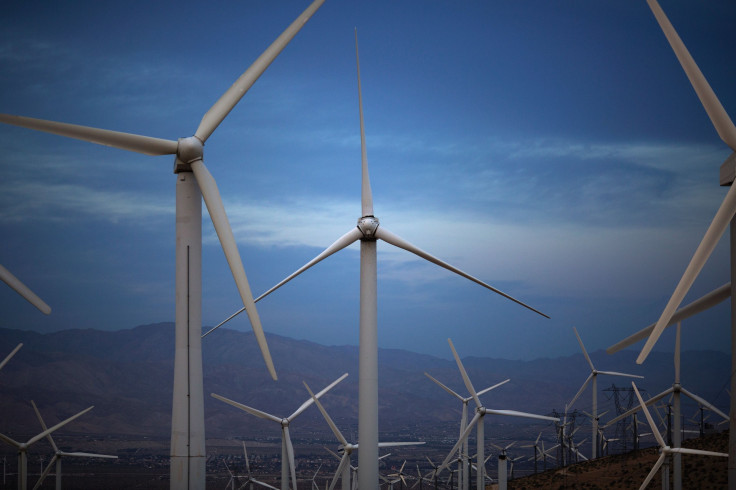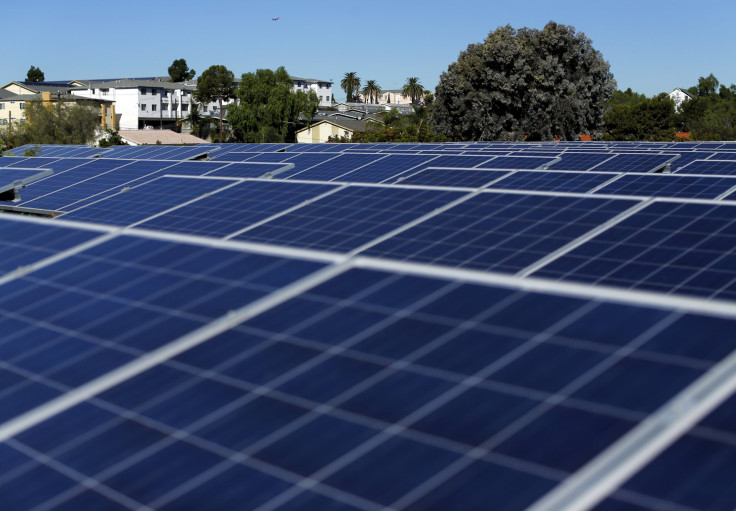Renewable Energy Sources: The Top 3 U.S. Utilities For Clean Energy Sales

Clean energy is steadily crowding out fossil fuels across the U.S. electric grid. But only a handful of utility companies are responsible for much of the surge in solar and wind power and energy efficiency programs, Ceres, a sustainable investing organization, found in a Tuesday report.
Here are the top three performers and the three biggest laggards — plus a deeper look at how plunging renewable energy costs are fueling a transition to low-carbon alternatives.
Best in Class
- Sempra Energy (NYSE:SRE): The San Diego holding company got 36.5 percent of its total retail electricity sales from renewables in 2014, Ceres said. Sempra produced more than 6 million megawatt-hours of renewables. (Ceres does not count utility-scale hydroelectric or nuclear power in its survey of 30 major investor-owned utilities.)
- PG&E Corp. (NYSE:PCG): The San Francisco holding company produced nearly 19.5 million megawatt-hours of renewable electricity, about a fourth of the company’s retail sales.
- Edison International (NYSE:EIX): The parent company of Southern California Edison, based in Rosemead, generated 17.5 million megawatt-hours of clean power, or 23 percent of its retail sales.
The Laggards
- Florida Power & Light Co.: The Juno Beach subsidiary of NextEra Energy produced just 177,000 megawatt-hours of renewables in 2014, or about 0.17 percent of its total retail electricity sales.
- American Electric Power Co. Inc. (NYSE:AEP): The holding company is the nation’s largest owner of coal-fired power plants. The Columbus, Ohio, utility produced about 1 million megawatt-hours of clean power, but given the company’s size, that amounted to only 0.89 percent of its retail sales.
- Consolidated Edison Inc. (NYSE:ED): The New York City holding company generated nearly 209,000 megawatt-hours in renewable energy, about 0.94 percent of total retail sales.

Notice a pattern among the best performers? The utilities are all based in California, the state with the most aggressive renewables mandate. The Golden State requires power companies to get at least 25 percent of sales from renewables by the end of 2016 and 50 percent by 2030. Utilities that get a smaller percentage of their retail sales from renewables tend to reside in states with weaker portfolio standards or incentives programs.
In both camps, however, utility stock prices are higher than they were this time last year. Shares of Sempra are up 10.75 percent, and shares in PG&E and Edison are up 25.5 percent and about 34 percent, respectively. Shares of AEP are up nearly 29 percent, and ConEd is up about 35.7 percent, compared with June 29, 2015. Florida Power & Light is not listed, but its parent company, NextEra Energy Inc. (NYSE:NEE), a major clean energy developer, is trading about 30 percent higher.
Aside from state renewables requirements, plunging clean energy costs are another key reason why utilities are adding increasing amounts of low-carbon resources to their conventional mix of coal, natural gas or nuclear power.
“Renewable energy has really become remarkably competitive over the last few years,” said Frank Prager, vice president of policy and federal affairs for Xcel Energy Inc. (NYSE:XEL). The Minneapolis-based utility, the No. 1 provider of U.S. wind energy, had the fourth-highest share of renewable sales on Ceres’ list. About 21 percent of Xcel’s 2014 retail sales — or nearly 18.5 million megawatt-hours — were from wind and other clean sources.
Significant advancements in wind turbine and solar panel technologies, combined with federal tax credit programs for wind and solar developers, have helped bring the costs of renewables closer to those of fossil fuels in many places. “Those two things together have resulted in a very competitive product,” Prager added.
In Michigan, for instance, the combined costs of meeting the state’s renewable energy and energy efficiency mandates is about $37.43 per megawatt-hour — far less than the cost of building a new coal- or natural gas-fired power plant, Michigan utility regulators found in February.
Clean energy is projected to get even cheaper as technology improves and more projects are installed in the U.S. and globally. Producing power from solar photovoltaics could cost nearly 60 percent less in 2025 than in 2015, the International Renewable Energy Agency, a United Nations-backed organization, said in a June 22 report. Offshore and onshore wind costs could fall 35 percent and 26 percent, respectively.
To hit those numbers, policymakers and companies will need to work harder to reduce “balance of system” costs: the time and money spent navigating red tape; operations and maintenance expenses; the price of cabling, wires and mounting systems; and higher financing costs from banks that still consider renewables to be risky. “It’s making sure the policies are optimized so that there’s sufficient competition and not too many regulatory or administrative barriers,” Michael Taylor, a senior analyst at the U.N. agency, said by phone from Germany.
In the United States, clean energy advocates say a more coherent, nationwide strategy is needed to ensure that all utilities — not just a progressive few — are producing more low-carbon electricity. The Obama administration’s Clean Power Plan would do that by forcing states to lower their total carbon emissions by up to 32 percent by 2030, from 2005 levels. The Environmental Protection Agency finalized the plan last summer, but a slew of lawsuits and a U.S. Supreme Court decision to stay the policy’s implementation may threaten its final adoption.
Prager said that despite confusion at the federal level, Xcel Energy will continue to work with the states where it operates to reduce carbon dioxide emissions and install more wind and solar projects. “We are strong believers that we have done it the right way, and we’re going to continue to do it, no matter what happens with that regulation,” he said.
© Copyright IBTimes 2024. All rights reserved.





















